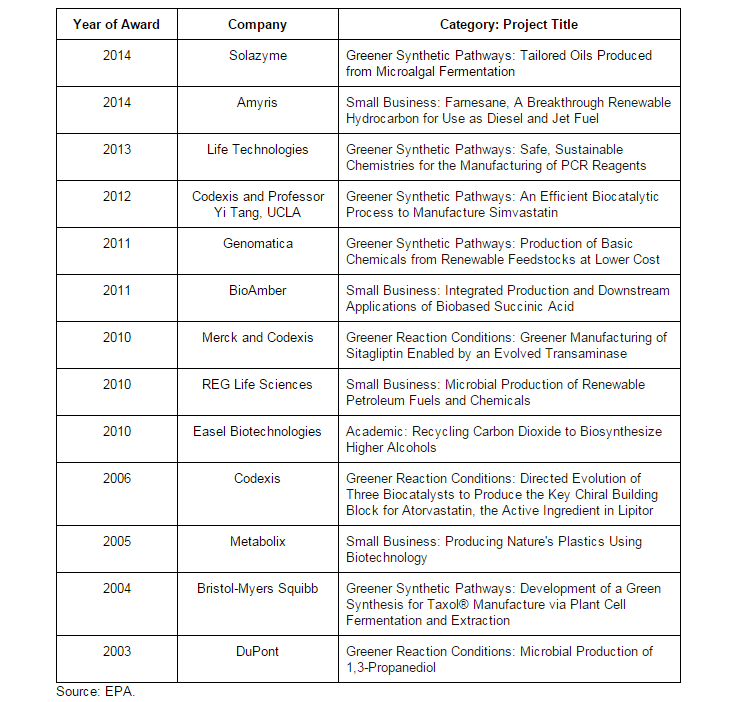Biomanufacturing Scale Up
Synthetic Biology Bags Two More Presidential Green Chemistry Challenge Awards
Oct 28, 2014
Earlier this month Amyris and Solazyme, industrial biotechs hailing from the first wave of synthetic biology, were awarded Presidential Green Chemistry Challenge Awards from the U.S. Environmental Protection Agency. The award was started to promote the use of, well, green chemistry, or technologies that reduce the consumption and creation of hazardous byproducts, enable efficient water usage, and bypass emissions. Considering that synthetic biology can be a powerful tool for creating commercial products that represent efficiency and process gains over existing technologies and production platforms, it should be no surprise that 13 of the 98 awards reside within the field -- and 12 of 50 total non-academic awards since 2003.
What is the significance of the award?
The EPA handed out its first Presidential Green Chemistry Challenge Awards in 1996. Since then the agency has received over 1,500 nominations, named 98 winners ranging from small academic research labs to world-leading companies, and handed out millions of dollars in funding through its Small Business Innovative Research (SBIR) Program. Winning technologies have netted the following achievements:
826 million pounds of hazardous chemicals and solvents eliminated each year -- enough to fill almost 3,800 railroad tank cars or a train nearly 47 miles long.
21 billion gallons of water saved each year -- the amount used by 820,000 people annually.
7.8 billion pounds of carbon dioxide equivalents released to air eliminated each year -- equal to taking 810,000 automobiles off the road.
And just think, progress from 93.5% of the total nominations (over 1,400 applications) are not tracked by the EPA.
What is the significance for synthetic biology?
The field has done quite well as far as the EPA is concerned. Companies utilizing the tools of synthetic biology have now won the “Greener Synthetic Pathways” category every year since 2011 and three of the last five "Small Business" category awards. Here’s a complete list of all 13 recognized commercial applications (Easel Biotechnologies was founded on technology that earned an academic award in 2010):

Important partners to young development stage companies in the field have also had a significant presence at the podium. The Dow Chemical Company has earned seven awards, BASF has won four, Merck and Co. three, Archer Daniels Midland two, DuPont one, and so on. For a complete list of all 98 winners, visit the EPA’s website for the Presidential Green Chemistry Challenge Award.
It’s not over yet
It’s important to note that the awards recognize novel technologies that represent significant gains in efficiency and sustainability, not necessarily technologies that have been proven successful in the marketplace. However, given the fact that the synthetic biology field continues to build momentum, its a near certainty that more platforms built upon engineering biology will be recognized in the future. The best year was 2010, in which the field won three total awards, but who says synthetic biology can't sweep all five or six awards in a single year?
To learn more about the importance of green chemistry and how the EPA encourages sustainable technologies, check out the following video:
Note: Featured image provided by Raymond Bryson/Flickr.

















